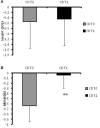Growth Hormone Receptor Gene Expression Increase Reflects Nutritional Status Improvement in Patients Affected by Crohn's Disease
- PMID: 30483486
- PMCID: PMC6240681
- DOI: 10.3389/fped.2018.00338
Growth Hormone Receptor Gene Expression Increase Reflects Nutritional Status Improvement in Patients Affected by Crohn's Disease
Abstract
Background: We proposed to verify the role of growth hormone receptor gene expression in growth failure of children with Crohn's disease (CD). Methods: We measured serum levels of growth hormone binding protein (GHBP) and insulin-like growth factor-I (IGF-I), and growth hormone receptor (GHR) gene expression in peripheral blood mononuclear cells of 21 patients with CD (before and after therapy) and in 27 age-sex-matched controls. Results: At diagnosis, significantly lower insulin-like growth factor-I and growth hormone binding protein levels were found in the CD group compared to the controls. Growth hormone receptor mRNA expression was lower in patients at diagnosis compared to the controls, even though the difference did not reach statistical significance, and significantly increased in patients in the following year. Insulin-like growth factor-I levels showed significant improvements 1 year after diagnosis compared to basal levels. On the contrary, growth hormone binding protein values had not significantly changed after 1 year of therapy. Conclusion: Our study raises the hypothesis of another mechanism through which cytokines interact with the growth hormone/insulin-like growth factor-I (GH/IGF-I) axis.
Keywords: Crohn's disease; GHBP; IGF-I; growth hormone receptor; inflammation; short stature.
Figures


References
LinkOut - more resources
Full Text Sources

